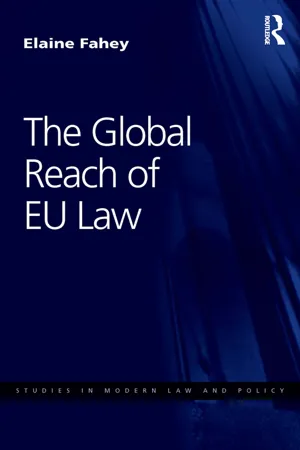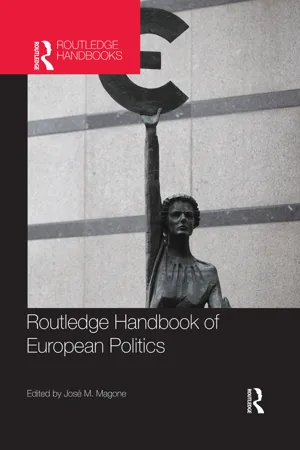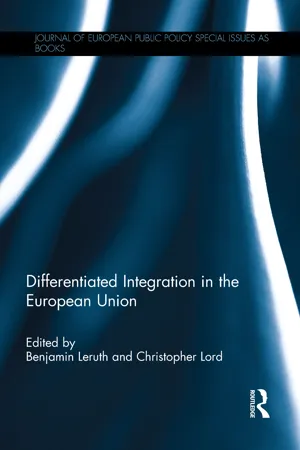Politics & International Relations
The EU
The European Union (EU) is a political and economic union of 27 member states located primarily in Europe. It aims to promote peace, stability, and economic prosperity among its members through the establishment of a single market, a customs union, and the adoption of common policies. The EU also plays a significant role in international relations, representing a collective voice on global issues.
Written by Perlego with AI-assistance
Related key terms
5 Key excerpts on "The EU"
- eBook - ePub
The European Union
Politics and Policies
- Jonathan Olsen(Author)
- 2020(Publication Date)
- Routledge(Publisher)
PART IHistoryPassage contains an image
CHAPTER 1
What Is The EUropean Union?CHAPTER OVERVIEW
• Because The EU is a political arrangement that defies easy categorization, it has stirred a much more vigorous theoretical debate about how to understand it than there has been for conventional states, such as the US.• How we approach The EU still depends in large part on how we think about the role of the state. Consequently, there are at least five ways to conceptualize The EU – as an international organization, a regional integration association, a political system in its own right, a unique entity, or something that exhibits and combines all four of these.• Theories analyzing The EU can be divided into two broad categories: those explaining how The EU evolved and those explaining what it has become. While the first category – which includes the theories of neofunctionalism and intergovernmentalism – was long dominated by scholars of international relations, the second category has increasingly become the province of scholars of comparative politics. The latter see The EU as a political system with its own institutions, processes, procedures, and policies. In recent years the term multi-level governance has emerged as one way to understand The EU as a political system.Numerous books have been published on national systems of politics and government, but rarely do they begin with a chapter defining their subject. No survey of the US, for example, would begin by asking “What is the United States?” We know that it is a country with an established and self-contained political system, with institutions bound together by laws and political processes, and for which there is a multitude of explanatory theories and an extensive political science vocabulary. But The EU is an animal of a different stripe: it is a unique political arrangement that defies easy definition or categorization and defies orthodox ideas about politics and government. It is clearly much more than a conventional international organization, but it is less than a European superstate. We do not even have a noun that comfortably describes The EU: for some it is an “actor,” but for others it is simply sui generis - eBook - ePub
- Elaine Fahey(Author)
- 2016(Publication Date)
- Routledge(Publisher)
Although it has ‘single legal personality’ – i.e. formal authority to act – The EU has a broad range of ‘statuses’ in international organisations. 18 Sometimes it acts alongside its member states, sometimes it does not. It faces the reality that international agreements cannot be easily renegotiated. And some international organisations cannot easily change their admission rules. While The EU treaties are no obstacle to EU participation in international organisations (e.g. Articles 220 TFEU, 221 TFEU), this contrasts sharply with its treaty-making activities. Yet each instance has its own particularities and history. The EU has been confined in its treaties to specific arrangements for the Food and Administration Organization (FAO), The EUropean Bank for Reconstruction and Development (EBRD), the World Trade Organization (WTO), Codex Alimentarious and the Hague Conference of Private International law. It is not a member of the United Nations, International Labour Organization, World Bank, International Monetary Fund or Council of Europe for reasons of sovereignty of the member states as much as the rules of the organisations themselves. 19 And an ‘apprehensive’ approach towards EU membership within the UN system exists. 20 Even if it is neither coherent nor optimal, The EU and its member states continue to co-exist and function together, globally. The EU is often referred to as a ‘global actor’; such a view of its ‘actorness’ is not always shared across disciplines, vexed by the structure of The EU and its practices. 21 These challenges are not limited to The EU in the outside world. Internally, The EU comprises very powerful institutional components that sometimes appear more powerful than the sum of its parts. They are broadly understood as actors engaged in rule-making after the state - eBook - ePub
- José M. Magone(Author)
- 2014(Publication Date)
- Routledge(Publisher)
In the more comprehensive Type I governance (within which Type II arrangements are embedded), multilevel governance has a statist and institutional core (see Eising 2004: 215). Public actors from at least two levels of government share political authority in formal institutional arrangements. Public actors at the upper level are to some extent autonomous, but lower-level units ‘are not subordinate’ (Mayntz 1999: 101). The EU is usually considered to be a general-purpose jurisdiction, not just a special-purpose jurisdiction (see Jachtenfuchs 2010: 204–5). Notwithstanding its lack of statehood, The EU has a much broader institutional remit than international regimes, and it exerts governing functions within a clearly delineated territory, namely within the borders of its 28 member states. In The EU, several institutions with autonomous powers have been established at the upper (supranational) level: The EUropean Commission, The EUropean Parliament and The EUropean Court of Justice. Its constituent lower-level units, The EU member states, have very strong participatory and decision-making rights, notably through their representation in the Council of The EU and The EUropean Council, and election rights with respect to the College of Commissioners and the judges of The EUropean Court of Justice. The EU Council shares executive functions with the Commission and legislative functions with The EUropean Parliament. In general, a qualified majority (if not all of the member states) must agree to legislative decisions taken at The EU level. In comparison to most national federal systems, EU multilevel governance is very dynamic and has undergone continuous evolution. After 60 years of European integration, it now covers an enormous range of policy areas, largely relying on regulatory policies to create, police and correct the common market. In several of these issue areas, the member states can no longer take autonomous decisions, either on legal or factual grounds. Hence, there is a pronounced need for cooperation and coordination among The EU institutions and national institutions in The EU multilevel system.However, The EU also incorporates important elements of Type II governance. At the most general level, The EU’s authority varies significantly across and also within policy areas, as well as along the policy-making cycle. Although The EU has significant policy-making capacities, it depends to a large extent on the implementation capacities of its member states. More specifically, The EU displays some elements of flexible integration. Some member states have opted out of specific EU policies (see Jachtenfuchs 2010). For example, a subgroup of member states in The EUrozone has adopted a common currency and common institutions (such as The EUropean Central Bank), whereas other member states have kept their own currencies and regimes of monetary policy. In a similar vein, the Schengen system unites those 21 EU member states that have abolished border controls among themselves as well as Switzerland, Norway, Iceland and Liechtenstein; however, the United Kingdom and Ireland have decided not to participate in this system. With the Amsterdam Treaty, The EU introduced provisions to enforce the cooperation of EU member states, although they have been infrequently invoked. These provisions, which presuppose the failure of EU member states to reach unanimous agreement on legislation beforehand, were first used in 2010 when 14 EU member states supported the adoption of a Council Regulation in the area of law applicable to divorce and legal separation. In 2012, this method was used to establish a unitary patent protection system. In February 2013, the Commission suggested the implementation of a financial transactions tax to reduce speculative trading and force the financial sector to contribute to the cost of the financial crisis. This proposal was supported by a group of 11 countries. As these examples illustrate, European governance consists mostly of Type I governance, but includes important elements of Type II governance. - eBook - ePub
The EU's Foreign Policy
What Kind of Power and Diplomatic Action?
- Mario Telò, Frederik Ponjaert(Authors)
- 2016(Publication Date)
- Routledge(Publisher)
- Other bodies matter within the revised complex foreign policy system_ first, the rotating Council presidencies, which, despite their relative decline (see the last controversial old-style performance by Spain in 2010), has not disappeared: they remain relevant as far as several crucial external policies are concerned (trade, development, humanitarian aid, etc.) by setting the Council agenda and promoting priorities. Second, The EUropean Parliament, notwithstanding its limited competence in foreign policy, has shown its relevance on many occasions where external relations are concerned, even during the hard starting up debate (2010) about the EEAS budget and status. Its more assertive role is a factor of increasing complexity.
9 In the current debate about CFSP resources also the shift of The EUISS (a research institute and think tank about foreign policy dependent on the HR) from Paris to Brussels is discussed.Paradoxically, both the trends towards clarity and simplification, and institutional complexity, are increasing with the new Treaty and its implementation. The financial mechanism (Foreign Policy Instrument) confirms this tendency. Enhanced coherence, combined with increasing complexity and fragmentation, look to many as the paradoxical but quasi-final features of a mature EU polity.The EU: An Incipient Civilian Power
This chapter’s aim is to contribute to the literature on The EU’s international power, by going beyond two opposed oversimplified pictures. According to a realist critique, The EU cannot be considered as a power at all: it is condemned to internal fragmentation and external irrelevance (a view furthered by evidence that: it is not a fully-fledged military and political power and thus submitted to NATO;10 it was irrelevant in the face of the Arab revolts, Israeli-Palestinian conflict, Iranian challenge, or the Korean crisis; and it looks unable to cope with its internal complexity). The second, more idealist picture, presents The EU an alternative kind of power, a post-Westphalian values-based community and strategic actor in the making. The EUropean Union has been described in mainstream interpretations as a ‘normative power’ (Manners 2002 ), essentially characterized by a distinctive normative basis consistent with the UN Charter, asserted through ‘a series of declarations, treaties, policies, criteria and conditions’.10 - eBook - ePub
- Benjamin Leruth, Christopher Lord(Authors)
- 2017(Publication Date)
- Routledge(Publisher)
The EUropean Union as a system of differentiated integration: interdependence, politicization and differentiation Frank Schimmelfennig, Dirk Leuffen and Berthold RittbergerABSTRACT This contribution conceptualizes The EUropean Union (EU) as a system of differentiated integration characterized by both variation in levels of centralization (vertical differentiation) and variation in territorial extension (horizontal differentiation) across policy areas. Differentiation has been a concomitant of deepening and widening and has increased and consolidated as The EU’s powers, policy scope and membership have grown. Turning to explanation, the contribution attributes the pattern of differentiated integration in The EU to the interaction of interdependence and politicization. Differentiation among the member states (internal differentiation) results from supranational integration under conditions of high interdependence and politicization. By contrast, external differentiation (the selective policy integration of non-member states) occurs in highly interdependent but weakly politicized policy areas. These constellations are illustrated in case studies of differentiation in the internal market, monetary union and defence.INTRODUCTION
‘What is The EUropean Union (EU)?’ and ‘How does it develop?’ are the perennial questions driving the study of European integration. In order to answer these questions, the theory and research of European integration has predominantly focused on the expansion of The EU’s tasks, competencies and membership. The big debates in European integration theory between different versions of neofunctionalism and intergovernmentalism have focused empirically on big ‘deepening’ decisions such as the establishment of The EUropean Communities (e.g., Haas 1958; Milward 1984), the Single Market, or Economic and Monetary Union (EMU; e.g., Moravcsik 1998; Sandholtz 1993; Sandholtz and Zysman 1989). More recently, ideational approaches have been applied to the same turning points (Parsons 2003), as well as to EU enlargement (Schimmelfennig 2003). In all of these studies, the issue has been why and under what conditions The EU deepens or widens and what this tells us about its nature. In this context, instances of differentiation such as the opt-outs from EMU, the transitional arrangements for new member states or the association of non-member countries were mainly seen as (temporary or marginal) side effects of negotiations on bargaining about ‘more integration’.
Learn about this page
Index pages curate the most relevant extracts from our library of academic textbooks. They’ve been created using an in-house natural language model (NLM), each adding context and meaning to key research topics.




